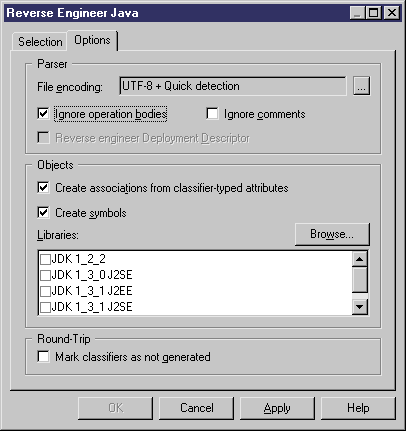The options tab allows you to specify various reverse engineering options.

The following Java reverse engineering options are available. Note that some may be disabled depending on the type of Java files being reversed:
|
Option |
Result of selection |
|---|---|
|
File encoding |
Specifies the default file encoding of the files to reverse engineer. |
|
Ignore operation bodies |
Reverses classes without including the body of the code. This can be useful when you want to reverse objects for visualization or comparison purposes, or to limit the size of your model if you have a very large number of classes to reverse. |
|
Ignore comments |
Reverses classes without including code comments. |
|
Reverse engineer Deployment Descriptor |
Reverses components with deployment descriptor. For more information, see Reverse Engineering EJB Components, Reverse Engineering Servlets, and Reverse Engineering JSPs. |
|
Create associations from classifier-typed attributes |
Creates associations between classes and/or interfaces. |
|
Create symbols |
Creates a symbol for each object in the diagram. If this option is not selected, reversed objects are only visible in the browser. |
|
Libraries |
Specifies a list of library models to be used as references during reverse engineering. The reverse engineered model may contain shortcuts to objects defined in a library. If you specify the library here, the link between the shortcut and its target object (in the library) will be preserved and the library will be added to the list of target models in the reverse engineered model. You can drag and drop the libraries in the list in order to specify a hierarchy among them. PowerDesigner will seek to resolve shortcuts found in the reverse engineered model against each of the specified libraries in turn. Thus, if library v1.1 is displayed in the list above library v1.0, PowerDesigner will first attempt to resolve shortcuts against library v1.1 and will only parse library v1.0 if unresolved shortcuts remain. You should use the List of Target Models to manage libraries related to the reverse engineered model, for example, you can change the library version (see Core Features Guide > Linking and Synchronizing Models > Shortcuts and Replicas > Working with Target Models). |
|
Mark classifiers as not generated |
Specifies that reversed classifiers (classes and interfaces) will not be generated from the model. To subsequently generate the classifier, you must select the Generate check box in its property sheet. |